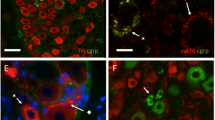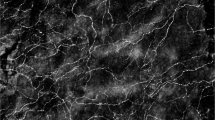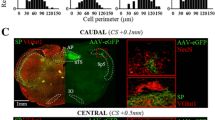Summary
Using selective surgical ablations we have investigated the localization of vanilloid receptors (specific [3H]resiniferatoxin binding sites) on terminals of the pelvic, hypogastric, and pudendal nerves in the rat urinary bladder. Pelvic and hypogastric nerve resections resulted in 90%6 and 25% loss of specific [3H]resiniferatoxin (RTX) binding sites, respectively, whilst pudendic nerve resection had no measurable effect on the binding. In control animals, the density of vanilloid receptors was 1.7-fold higher in the neck than in the dome of the urinary bladder; the Bmax values were 57±8 and 34±7 fmol/mg protein, respectively. The binding characteristics of the vanilloid receptor were similar in the urinary bladder of the rat and mouse: Kd values were 87±15 and 61±11 pM, Bmax values were 37±2 and 60±10 fmol/mg protein, respectively. In contrast to the findings for the rat and mouse, in the urinary bladder of the guinea pig and the hamster the low level of specific [3H]RTX binding prevented the detailed characterization of vanilloid receptors. Nonetheless, at a fixed (60 pM) concentration of [3H]RTX, specific binding both in the guinea pig and hamster urinary bladder was approximately 20% of that in the rat urinary bladder. In the urinary bladder of newborn rats, as in adults, a single class of specific [3H]RTX binding sites was found which bound RTX with an affinity of 110±20 pM and with a maximal binding capacity of 30±5 fmol/mg protein. We conclude that, in accord with the physiological findings, the majority of vanilloid receptors are located on terminals of the pelvic nerve in the rat urinary bladder with higher receptor density in the bladder neck as compared to the bladder dome. Whereas the comparably high density of vanilloid receptors in the rat and mouse urinary bladder and the low receptor density in the hamster are mirrored by the in vivo vanilloid-sensitivity of these species, the low level of vanilloid receptors in the urinary bladder of the guinea pig contrasts to the marked sensitivity of this species to capsaicin. We conclude that the level of vanilloid receptors is an important but not exclusive determinant of vanilloid-sensitivity.
Similar content being viewed by others
References
Alm P, Alumets J, Brodin E, Hakanson R, Nilsson G, Sjoberg NO, Sundler F (1978) Peptidergic (substance P) nerves in the genitourinary tract. Neuroscience 3:419–425
Baranowski R, Lynn B, Pini A (1986) The effects of locally applied capsaicin on conduction in cutaneous nerves in four mammalian species. Br J Pharmacol 89:267–276
Bevan S, James IF, Rang HP, Winter J, Wood JN (1987) The mechanism of action of capsaicin — a sensory neurotoxin. In: Jenner P (ed) Neurotoxins and their pharmacological applications. Raven Press, New York, pp 261–277
De Groat WC (1986) Spinal cord projections and neuropeptides in visceral afferent neurons. Prog Brain Res 67:165–187
Docherty RJ, Robertson B, Bevan S (1991) Capsaicin causes prolonged inhibition of voltage-activated calcium currents in adult rat dorsal root ganglion neurons in culture. Neuroscience 40:513–521
Fowler CJ, Jewkes D, McDonald WI, Lynn B, De Groat WC (1992) Intravesical capsaicin for neurogenic bladder dysfunction. Lancet 339:1239
George NJR, Gosling JA (1986) Sensory disorders of the bladder and urethra. Springer, Berlin Heidelberg New York
Glinsukon T, Stitmunnaithum V, Toskulkao C, Buranawuti T, Tangkrisanavinont V (1980) Acute toxicity of capsaicin in several animal species. Toxicon 18:215–220
Holzer P (1988) Local effector functions of capsaicin-sensitive sensory nerve endings: involvement of tachykinins, calcitonin gene-related peptide and other neuropeptides. Neuroscience 24:739–768
Holzer P (1991) Capsaicin: cellular targets, nechanisms of action, and selectivity for thin sensory neurons. Pharmacol Rev 43:144–201
Hulsebosch CE, Coggeshall RE (1982) An analysis of the axon populations in the nerves to the pelvic viscera in the rat. J Comp Neurol 211:1–10
Jancso G, Maggi CA (1987) Distribution of capsaicin-sensitive urinary bladder afferents in the rat spinal cord. Brain Res 418:371–376
Jancso N, Jancso-Gabor A, Szolcsanyi J (1967) Direct evidence for neurogenic inflammation and its prevention by denervation and by pretreatment with capsaicin. Br J Pharmacol Chemother 31:138–151
Jessell TM, Iversen LL, Cuello AC (1978) Capsaicin-induced depletion of substance P from primary sensory neurons. Brain Res 152:183–188
Lou YP, Karlsson JA, Franco-Cereceda A, Lundberg JM (1991) Selectivity of ruthenium red in inhibiting bronchoconstriction and CGRP release induced by afferent C-fibre activation in the guinea-pig. Acta Physiol Scand 142:191–199
Maggi CA (1991 a) The role of peptides in the regulation of the micturition reflex, an update. Gen Pharmacol 22:1–24
Maggi CA (1991 b) The pharmacology of the efferent function of sensory nerves. J Anton Pharmac 11:173–208
Maggi CA (1992) Therapeutic potential of capsaicin-like molecules: studies in animals and humans. Life Sci/Pharm Lett 51:1777–1781
Maggi CA, Meli A (1988) The sensory-efferent function of capsaic-insensitive sensory neurons. Gen Pharmacol 19:1–43
Maggi CA, Santicioli P, Borsini F, Giuliani S, Meli A (1986) The role of the capsaicin-sensitive innervation of the rat urinary bladder in the activation of the micturition reflex. Naunyn-Schmiedeberg's Arch Pharmacol 332:276–283
Maggi CA, Santicioli P, Abelli L, Parlani M, Capasso M, Conte B, Giuliani S, Meli A (1987a) Regional differences in the effects of capsaicin and tachykinins on the motor activity and vascular permeability of the rat lower urinary tract. Naunyn-Schmiedeberg's Arch Pharmacol 335:636–645
Maggi CA, Giuliani S, Santicioli P, Abelli L, Geppetti P, Somma V, Renzi D, Meli A (1987b) Species-related variations in the effects of capsaicin on urinary bladder functions: relation to bladder content of substance P-like immunoreactivity. Naunyn-Schmiedeberg's Arch Pharmacol 336:546–555
Maggi CA, Santicioli P, Geppetti P, Furio M, Frilli S, Conte B, Fanciullacci M, Giuliani S, Meli A (1987c) The contribution of capsaicin-sensitive innervation to activation of the vesico-vesical reflex in rats: relationship between substance P levels in the urinary bladder and the sensory-efferent function of capsaicin-sensitive sensory neurons. Brain Res 415:1–13
Maggi CA, Barbanti G, Santicioli P, Beneforti P, Misuri D, Meli A, Turini D (1989) Cystometric evidence that capsaicin-sensitive nerves modulate the afferent branch of micturition reflex in humans. J Urol 142:150–154
Maggi CA, Patacchini R, Tramontana M, Amann R, Giuliani S, Santicioli P (1990) Similarities and differences in the action of resiniferatoxin and capsaicin on central and peripheral endings of primary sensory neurons. Neuroscience 37:531–539
Meini S, Evangelista S, Geppetti P, Szallasi A, Blumberg PM, Manzini S (1992) Pharmacological and neurochemical evidence for the activation of capsaicin-sensitive nerves by lipoxin A4 in guinea pig bronchus. Am Rev Resp Dis 146:930–934
Miller MS, Buck SH, Sipes IG, Yamamura HI, Burks TF (1982) Regulation of substance P by nerve growth factor: disruption by capsaicin. Brain Res 250:193–196
Santicioli P, Maggi CA, Meli A (1986) Functional evidence of a capsaicin-sensitive innervation of the rat urinary bladder. J Pharm Pharmacol 38:446–451
Su HC, Wharton J, Polak JM, Mulderry PK, Ghatei MA, Gibson SJ, Terenghi G, Morrison JFB, Ballesta J, Bloom SR (1986) Calcitonin gene-related peptide immunoreactivity in afferent neurons supplying the urinary tract: combined retrograde tracing and immunohistochemistry. Neuroscience 18:727–747
Szallasi A, Blumberg PM (1990a) Minireview: Resiniferatoxin and its analogs provide novel insights into the pharmacology of the vanilloid (capsaicin) receptor. Life Sci 47:1399–1408
Szallasi A, Blumberg PM (1990b) Specific binding of resiniferatoxin, an ultrapotent capsaicin analog, by dorsal root ganglion membranes. Brain Res 524:106–111
Szallasi A, Blumberg PM (1992a) Resiniferatoxin. In: Conn PM (ed) Methods in neurosciences, vol 8, Neurotoxins. Academic Press, Orlando, FL, pp 368–380
Szallasi A, Blumberg PM (1992b) Vanilloid receptor loss in rat sensory ganglia associated with long term desensitization to resiniferatoxin. Neurosci Lett 136:51–54
Szallasi A, Blumberg PM (1993) [3H]resiniferatoxin binding by the vanilloid receptor: species-related differences, effects of temperature and sulfhydryl reagents. Naunyn-Schmiedeberg's Arch Pharmacol 347:84–91
Szallasi A, Lewin NE, Blumberg PM (1992) Identification of alpha1,-acid glycoprotein (orosomucoid) as a major vanilloid-binding protein in serum. J Pharmacol Exp Ther 262:883–888
Szallasi A, Conte B, Goso C, Blumberg PM, Manzini S (1993) Characterization of a peripheral vanilloid (capsaicin) receptor in the rat urinary bladder. Life Sci (in press)
Yokokawa K, Sakanaka M, Shiosaka S, Tohyama M, Shiotani Y, Sonoda T (1985) Three dimensional distribution of substance P-like immunoreactivity in the urinary bladder of the rat. J Neural Transm 63:209–222
Author information
Authors and Affiliations
Additional information
Correspondence to A. Szallasi at the above address
Rights and permissions
About this article
Cite this article
Szallasi, A., Conte, B., Goso, C. et al. Vanilloid receptors in the urinary bladder: regional distribution, localization on sensory nerves, and species-related differences. Naunyn-Schmiedeberg's Arch Pharmacol 347, 624–629 (1993). https://doi.org/10.1007/BF00166945
Received:
Accepted:
Issue Date:
DOI: https://doi.org/10.1007/BF00166945




